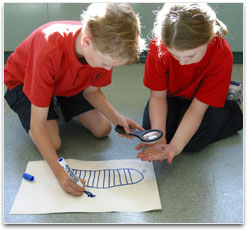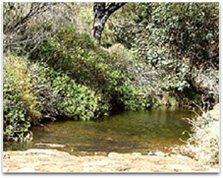Are Animals A Part Of The Environment
The environment: living and non-living things
Page Content
This focus idea is explored through:
- Contrasting student and scientific views
- Critical pedagogy ideas
- Didactics activities
- Further resources
Contrasting student and scientific views
Pupil everyday experience
 Students tend to think of organisms equally being only animals that interact with the physical environment and plants, without appreciating the complex interdependence between members of and across species.
Students tend to think of organisms equally being only animals that interact with the physical environment and plants, without appreciating the complex interdependence between members of and across species.
Research: Hubber & Tytler (2004)
Their ideas of ecosystems are usually just associated with natural and wilderness areas rather than their own environments. This concept of an ecosystem also influences their ideas about how humans collaborate with ecosystems, which is often in terms of the destruction or collapse of natural and wilderness ecosystems rather than those systems that are part of their more firsthand environments.
Research: Novak & Gowin (1984)
Scientific view
The world contains a wide diversity of concrete conditions, which creates a diverseness of environments where living things can exist found. In all these environments, organisms collaborate and employ available resources, such equally food, space, light, heat, water, air, and shelter. Each population of organisms, and the individuals within information technology, collaborate in specific ways that are express past and can benefit from other organisms.
Interactions between different organisms are numerous and are normally described according to their positive (beneficial), negative or neutral effect on others.
The interactions betwixt living things and their not living environment makes upward a total ecosystem; understanding any one office of it requires knowledge of how that role interacts with the others.
Ecosystems do non 'collapse' simply do alter in role, construction and limerick over time due to natural or human disturbance (examples include the impact of drought, flooding, mowing and herbicides).
Research: Novak and Gowin (1984)
Critical teaching ideas
- All organisms exist inside ecosystems.
- Living things take various structures that enable them to survive: for case, transport structures in plants allow water and trace elements to move. Similarly there are digestive structures and respiratory structures in animals and reproductive structures in plants and animals that help in organisms functioning inside ecosystems.
- Each organism has detail forms of these structures that assist their survival.
- In all environments, organisms with like needs may compete with one another for limited resources, including food, space, water, air and shelter.
![]() Explore the relationships between ideas most organisms and their interactions with their environments in the Concept Development Maps – (Flow of Energy in Ecosystems,Natural Selection)
Explore the relationships between ideas most organisms and their interactions with their environments in the Concept Development Maps – (Flow of Energy in Ecosystems,Natural Selection)
Students need to feel evidence of a functioning ecosystem with arable plant-animal interaction to develop a better understanding of the complexity of interactions and to understand that they themselves alive within ecosystems.
Fourth dimension is a gene that influences the type of interactions and changes that take place in an ecosystem. This is problematic for scientific discipline planning that does non let students to observe changes over an extended period of time. Allowing ongoing investigations to run throughout the yr is an important consideration (or alternatively apply video clips that record changes over time).
Enquiry: Skamp (2004)
Teaching activities
Collect evidence/information for analysis
Identify a project inside your local community where student research and involvement may have an impact.
Some examples are:
- Whale Dept. of Environment and H2o Resources - Coasts and oceans
- Marine Coastal Projects
- Adopt a Dolphin - Whale and Dolphin Conservation Society
- Dolphin Enquiry Institute
Research: Bakery (2005)
Claiming some existing ideas
In lodge to challenge the ideas that ecosystems simply be in wilderness areas and that human impact is ever negative, encourage students to undertake activities which allow them to investigate living things in a natural local surroundings such as the schoolyard, local pond, a wetland or a synthetic environs such as a classroom pond.
Enquiry: Skamp (2004)
Collect evidence/data for analysis
Studying swimming animals over a period of weeks gives a sense of the changes that occur in populations as they interact or in changes of form equally animals go through their lifecycles. Students can link this with a longer study to provide insights to seasonal changes and animal adaptations related to seasonal cycles. The ten office TV series The Life of Birds completed by Sir David Attenborough in 1998 provides some not bad examples of how birds accept adapted to urban environments.
Inquiry: Skamp (2004)
Focus student attention on disregarded detail
 Encourage students to record observations and descriptions of phenomena using scientific discipline journals, labelled diagrams, timelines and PowerPoint presentations. Use microscopes and hand held lenses to help observations of construction and function. For instance you lot could map a school pond or nearby wetland, rails where tadpoles are feeding and where other organisms are situated or motility in relation to each other.
Encourage students to record observations and descriptions of phenomena using scientific discipline journals, labelled diagrams, timelines and PowerPoint presentations. Use microscopes and hand held lenses to help observations of construction and function. For instance you lot could map a school pond or nearby wetland, rails where tadpoles are feeding and where other organisms are situated or motility in relation to each other.
Analyze and consolidate ideas for/past communication to others
Students could create a news written report on their project or develop a project similar creating a new playground. They could explore an effect for the media or their school newsletter from differing perspectives such equally a politician, a greenie, a farmer, a parent, a local elderberry or other teachers. This involves ethical decision-making on behalf of the students as to what to include and what not to include in the report.
Further resource
Science related interactive learning objects can be found on the FUSE Teacher Resource page.
To access the interactive learning object below, teachers must login to FUSE and search past Learning Resource ID:
- Environmental evaluation project: frog swimming habitat –students answer a short quiz about how organisms are adapted to their environment, then explore a swimming environs. They choose sampling tools suited to avert pain the animals or damaging the report expanse, then collect animals from a swimming, grassy bank, rocky bank, trees and shrubs. They look at a species description and video for each animal and describe how the fauna meets its basic needs for food, water, shelter and protection.
Learning Resource ID: R9QN9M
- Environmental evaluation project: frog pond habitat (2) – students explore why a frog population is declining by wait at changes in the pond over fourth dimension (specifically, water quality, habitat loss and predation past introduced species). Students build a food spider web for the swimming and model population interactions. They identify which species have the greatest impact on the frog and finally build a report using evidence collected to back up their conclusions.
Learning Resource ID: FTE6CS
Source: https://www.education.vic.gov.au/school/teachers/teachingresources/discipline/science/continuum/Pages/environment.aspx
Posted by: simsthicalin.blogspot.com

0 Response to "Are Animals A Part Of The Environment"
Post a Comment